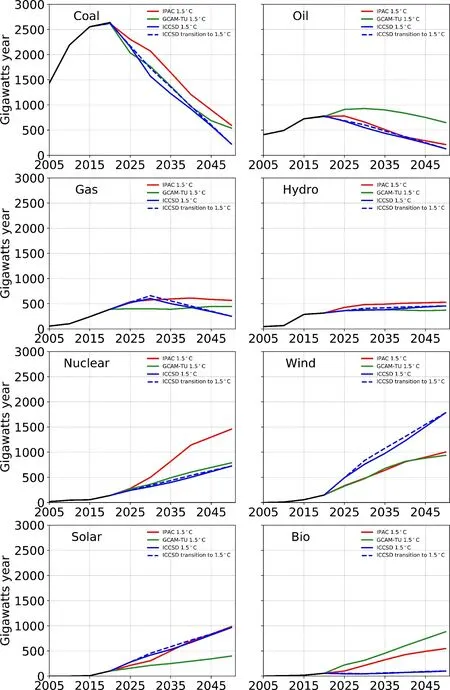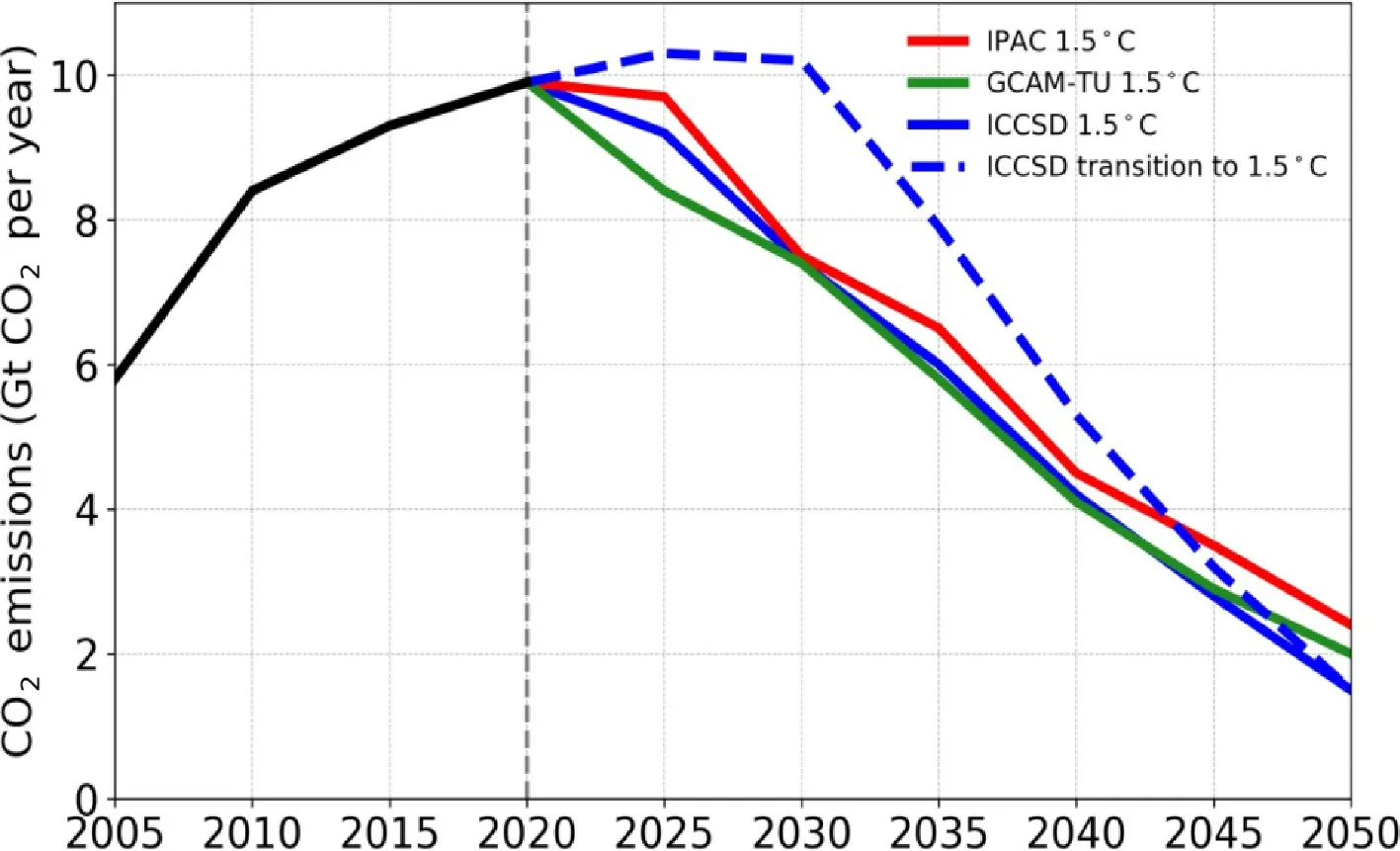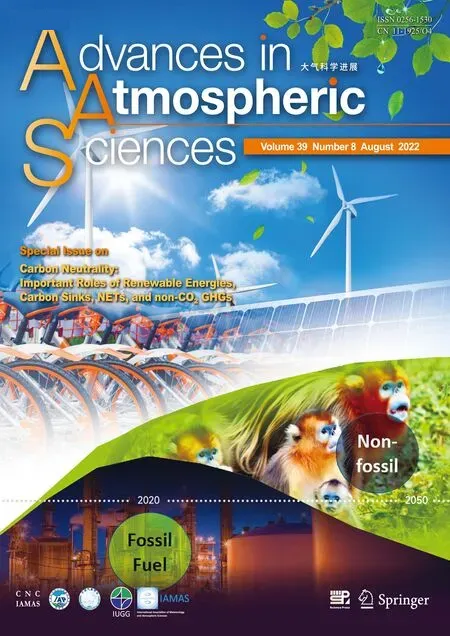Electronic Supplementary Material to:The Chinese Carbon-Neutral goal:Challenges and Prospects*
Ning ZENG , Kejun JIANG , Pengfei HAN , Zeke HAUSFATHER , Junji CAO ,Daniel KIRK-DAVIDOFF , Shaukat ALI, and Sheng ZHOU
1Department of Atmospheric and Oceanic Science,and Earth System Science Interdisciplinary Center,University of Maryland,College Park 20742,Maryland,USA
2State Key Laboratory of Numerical Modeling for Atmospheric Sciences and Geophysical Fluid Dynamics,Institute of Atmospheric Physics,Chinese Academy of Sciences,Beijing 100029,China
3Energy Research Institute,National Development and Reform Commission,Beijing 100045,China
4Carbon Neutrality Research Center,Institute of Atmospheric Physics,Chinese Academy of Sciences,Beijing 100029,China
5Breakthrough Institute,Oakland 94612,California,USA
6Institute of Atmospheric Physics,Chinese Academy of Sciences,Beijing 100029,China
7Global Change Impact Study Centre,Ministry of Climate Change,Islamabad 45250,Pakistan
8Institute of Energy,Environment and Economy,Tsinghua University,Beijing 100084,China
Integrated Assessment Models and scenarios used for the carbon-neutral goal
The 1.5°C scenario of the Intergovernmental Panel on Climate Change (IPCC) corresponds broadly to net-zero anthropogenic CO2emissions by 2050 (IPCC, 2018). In our analysis, four scenarios from Integrated Assessment Model (IAM) projections were used to evaluate China's carbon-neutral goal.

Fig.S1. Trajectories of China's primary energy sources in the four proposed scenarios.

Fig.S2. CO2 emissions trajectories from the four scenarios..

Fig.S3. Sectoral CO2 emissions from 2000-50. See Han et al., 2021 for details.
The linked Integrated Policy Assessment Model of China (IPAC) model (Jiang et al., 1998, 2010, 2018, 2019) is an integrated model developed by the Energy Research Institute (ERI) of the National Development and Reform Commission(NDRC) to analyze global, national, and regional energy and environment policies. It includes three sub-models: (1) the IPAC-Emission global model, (2) the IPAC-CGE model; (3) and IPAC-AIM/technology model. The IPAC-Emission model focuses on energy and land-use activities, and it was revised to include CH4, N2O, HFC, PHC, and SF6to simulate more gas emissions. The IPAC-CGE model is a general equilibrium model for China. It is mainly responsible for analyzing the economic impacts of different energy and environmental policies. It includes major sectors such as household, government, agriculture, energy, and other production sectors. IPAC-AIM/technology is the main component of the IPAC model, which selects technologies with the lowest costs to provide the energy service. It includes 42 sectors and their products and almost 600 technologies, including existing and potential technologies.
The Global Change Assessment Model Tsinghua University (GCAM-TU) model (Zhou et al., 2021) is adapted from the US GCAM (Edmonds and Reilly, 1983; Kyle et al., 2010), which is a global integrated assessment model with 32 divided regions, including China, and it is a long-term, partial-equilibrium model is designed to address issues on the behavior and interactions between energy, water, agriculture, land use, economy, and climate. The model has been developed at the US Department of Energy’s Pacific Northwest National Laboratory (PNNL) since the 1980s and has been widely used in energy consumption and CO2emissions research (Pan et al., 2018; Zhou et al., 2018a, 2021). It is an open-source model with transparent and verifiable parameters and data (Zhou et al., 2018a, b). The GCAM-TU adjusted the parameters and local policies to make it more suitable to simulate China’s energy and CO2emissions (Zhou et al., 2021). Specifically, the energy consumption and CO2emissions of China, as well as other major regions, in both the base year and the target year of the nationally determined contribution (NDC) were adjusted. Energy supply and demand data, including the power sector in the base year (2015), were recalibrated using China’s latest energy statistics. The future trends of the supply and demand of both energy and electricity were adjusted according to the latest domestic research results.
The ICCSD and ICCSD 1.5°C “transition pathway” from Tsinghua University have synthesized results from 18 research topics under a major project using multiple models (Project Comprehensive Report Preparation Team, 2020). The macro-analyses are based on trend analyses, while the study used sectoral models for sector-based emissions and projections. There were four basic scenarios: (1) Policy scenario; (2) Reinforced policy scenario; (3) 2°C scenario; (4) 1.5°C scenario. Considering the inertia in the energy system, two more pathways are proposed to ‘transition’ from the reinforced-policy scenario to the 1.5°C and the 2°C scenarios, implying more gradual changes before 2030 and more drastic changes after.Here we analyze the two carbon-neutral consistent pathways: the standard ICCSD 1.5°C scenario and the ICCSD transition to the 1.5°C scenario.
Among these models, while IPAC has long been a main in-house model used for economic and energy planning at NDRC, the other models have direct linkage with widely used global IAM models. Compared to most global models, they have adapted parameter values and assumptions more specific to China, thus potentially providing greater insight into China's carbon-neutral pathways.
 Advances in Atmospheric Sciences2022年8期
Advances in Atmospheric Sciences2022年8期
- Advances in Atmospheric Sciences的其它文章
- Preface to the Special Issue on Carbon Neutrality: Important Roles ofRenewable Energies, Carbon Sinks, NETs, and non-CO2 GHGs※
- Electronic Supplementary Material to:The Variability of Air-sea O2 Flux in CMIP6:Implications for Estimating Terrestrial and Oceanic Carbon Sinks*
- Electronic Supplementary Material to:The Synergism between Methanogens and Methanotrophs and the Nature of their Contributions to the Seasonal Variation of Methane Fluxes in a Wetland:The Case of Dajiuhu Subalpine Peatland*
- Electronic Supplementary Material to:Ocean-atmosphere Teleconnections Play a Key Role in the Interannual Variability of Seasonal Gross Primary Production in China*
- Electronic Supplementary Material to:Changes in Global Vegetation Distribution and Carbon Fluxes in Response to Global Warming:Simulated Results from IAP-DGVM in CAS-ESM2*
- The Synergism between Methanogens and Methanotrophs and the Nature of their Contributions to the Seasonal Variation of Methane Fluxes in a Wetland: The Case of Dajiuhu Subalpine Peatland※
